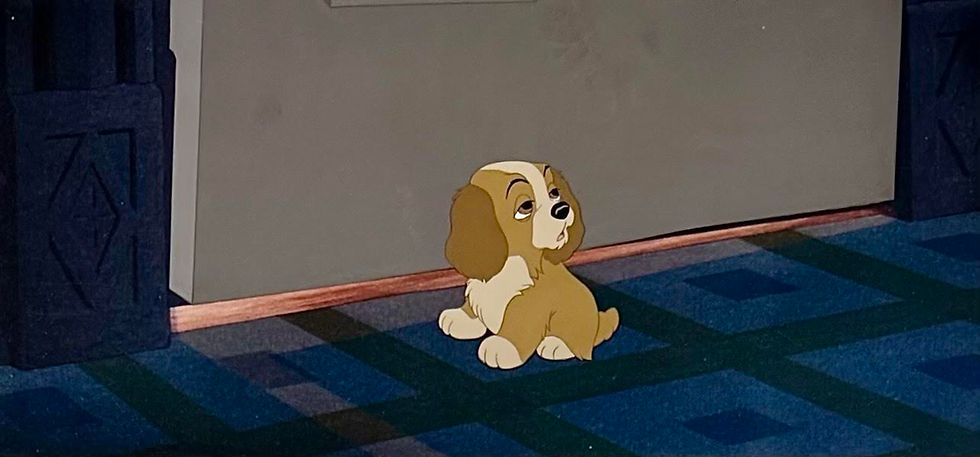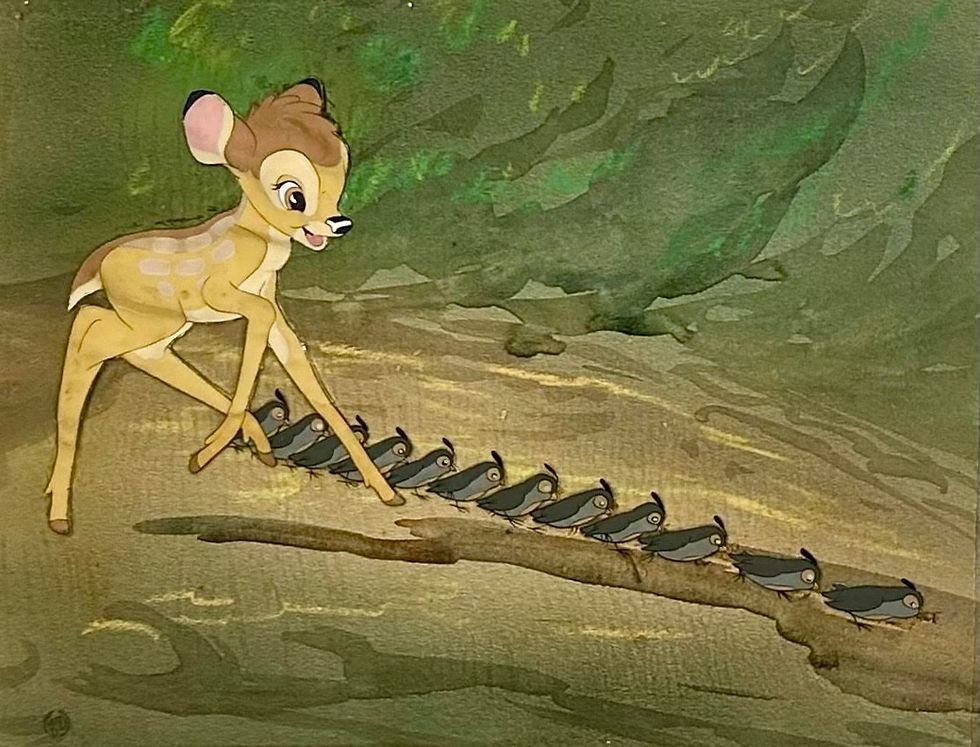Original Production Animation Cel of Pinocchio, Geppetto, and Figaro from "Pinocchio," 1940
- Untitled Art Gallery

- May 27, 2018
- 4 min read
Updated: May 28, 2018
Original hand painted and hand inked production animation cel of Pinocchio, Geppetto, and Figaro from "Pinocchio," 1940, Walt Disney Studios; Set on a hand prepared custom background with added water effects cel; Size - Pinocchio, Geppetto, & Figaro: 9 3/4 x 8 1/2", Image 12 1/4 x 15 3/4"; Unframed.
"Pinocchio! My boy. I'm so happy to see you!" - Geppetto
"Pinocchio," 1940 was the second animated feature film produced by Disney, and followed on the success of "Snow White and the Seven Dwarfs." 1937. It was released to theaters by RKO Radio Pictures on February 23, 1940 and was based on the Italian children's novel "The Adventures of Pinocchio" by Carlo Collodi. The general plot of the film involves an old wood-carver named Geppetto, who carves a wooden puppet that he names Pinocchio. One night the puppet is brought to life by the Blue Fairy, who informs him that he can become a real boy if he proves himself to be "brave, truthful, and unselfish". Pinocchio's journey to become a real boy is challenged by his encounters with an array of scrupulous characters.
"Pinocchio" became the first animated feature to win an Academy Award; it won for both Best Music - Original Score and for Best Music - Original Song for "When You Wish Upon A Star." Most critics and audiences agree that "Pinocchio" is among the finest Disney features ever made, and one of the greatest animated films of all time. In 1994, it was added to the United States National Film Registry as being "culturally, historically, or aesthetically significant."
Due to the huge success of "Snow White," Walt Disney wanted more famous voice actors for "Pinocchio." He cast popular singer Cliff Edwards (who had made the first record selling over a million copies) as Jiminy Cricket. Disney also wanted the character of Pinocchio to be voiced by a real child. The role ended up going to twelve year old actor Dickie Jones, who had previously been in Frank Capra's enormous Hollywood hit, "Mr. Smith Goes to Washington."
Animation began in September 1938 and just as in "Snow White," live-action footage was shot for "Pinocchio" with the actors playing the scenes; which was supervised by Hamilton Luske. The animators then used the footage as a guide for their animation drawings by studying the human movement and then incorporating many of those poses and scenes. The title character was animated by Milt Kahl (initial design), Frank Thomas, and Ollie Johnston. "When I was doing Pinocchio," Johnston said, "I thought of the character being real, a living person, not a drawing."
Geppetto is a very skilled woodcarver, and is able to make toys, figurines, clocks, and even articulated music boxes. One day he creates a wooden marionette puppet that he names Pinocchio, and makes a wish for him to become a real boy. Geppetto was voiced by Christian Rub, who was a character actor from the late 1910's to the early 1950's, and was featured in more than 100 movies. Geppetto was masterfully animated by Walt Disney animator Art Babbitt, who noted that Geppetto was his favorite character to animate.
According to veteran Walt Disney animator Andreas Deja:
"I had the chance to meet Art when he was still working for Dick Williams on The Thief and the Cobbler. He didn't mind talking about his Disney years and his strained relationship with Walt. I remember him saying that after he left Disney he never again animated a character with so much warmth like Geppetto. He felt it was one of the best things he ever did. I would agree, the level of depth Babbitt was able to inject into the character's acting is astounding. Geppetto just loves this wooden puppet that came to life, and when he looses Pinocchio, his whole world seems to fall apart. But he still has enough hope and searches on to find his "son". A real high in character animation."
Figaro is Geppetto's pet Tuxedo Cat and was Walt Disney's favorite character in the film. He loved the kitten so much, he wanted him to appear in as many scenes as possible. Once production on "Pinocchio" was completed; Walt made him Minnie Mouse's pet, replacing her dog Fifi. Figaro was also given his own series of cartoon shorts, as well as costarring in other cartoon shorts with Pluto.
The master Walt Disney animator Eric Larson was in charge of animating Figaro, and based the kitten's design on the childlike personality of his own nephew. The famous character actor Mel Blanc (known as "The Man of Thousand Voices") provided the voice of Figaro.
This is an absolutely perfect image of Geppetto, Pinocchio, and Figaro; placed on on a hand prepared custom background and with an added water effects cel. All three main characters are eyes and mouth open, smiling, and are in a fantastic pose! The cel is from the scene when Geppetto and Figaro have been swallowed by the whale Monstro and are living on an abandoned shipwreck inside the belly of the beast. One day Monstro, while eating a school of tuna, also swallows Pinocchio; who had gone out in search of his father. Geppetto is catching some of the tuna that Monstro had just swallowed when he also catches and reels in Pinocchio! This is the cel from that scene when all three characters, Geppetto, Figaro, and Pinocchio are happily reunited and Geppetto exclaims "Pinocchio! My boy. I'm so happy to see you!" What is amazing is that Walt Disney Studios created a limited edition cel of this exact scene, and the frame chosen is an almost perfect match to this original production cel. A great piece of animation history and a true highlight to any animation art collection!
To The Gallery Page: CLICK HERE:
https://www.untitledartgallery.com/pinocchio
#Pinocchio #JiminyCricket #CliffEdwards #BlueFairy #Geppetto #WaltDisney #Disney #untitledartgallery #animation #animationart #cel #animationdrawing #productiondrawing #DickieJones #MiltKahl #FrankThomas #OllieJohnston #Bach #SandyStrother #JoeGrant #JackCampbell #MargeChampion #HamiltonLuske #JohannSebastianBach #Bach #OskarFischinger #JeanHarlow #EvelynVenable #EricLarson #Figaro #Cleo #MelBlanc #DisneyCat #ArtBabbitt #ChristianRub #Monstro







